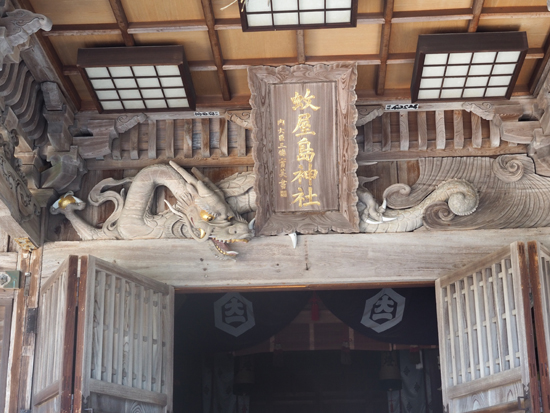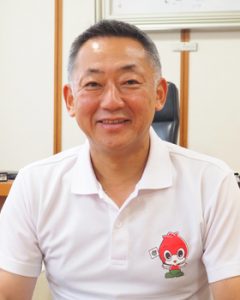Series ”Visiting the village” in search of the key to regional revitalization 14 Hiezu Village, Tottori Prefecture


中田達彦村長(Mayor Nakata Tatsuhiko)
Hiezu Village, located in the western part of Tottori Prefecture, is surrounded on three sides by Yonago City and has a population of about 3,600.
We say “only” because it has never merged since the establishment of the town and village system in 1889 (Meiji 22). This is also the only village in Tottori Prefecture.
Originally an agricultural village, the village attracted an Oji Paper factory in 1952 and has since developed mainly around secondary industries.
In addition, National Route 431 was opened in 1985. The village’s convenient location near the Yonago Expressway Yonago IC has also helped to promote commerce.
The village is lined with chain stores such as Aeon, McDonald’s, and Sukiya. The general image of a village is a rural landscape surrounded by abundant nature, but Hiezu Village is different from that image and instead exudes the atmosphere of a city suburb.
Mayor Nakata Tatsuhiko says, “The population is gradually increasing. Many people have moved here from nearby areas, and it is characterized by a large number of employees.”
One of the reasons for the population increase is the detailed support for child-rearing generations. For example, they have adopted a system called Neuvola. Neuvola originated in Finland and is a system that provides one-stop health services and child-rearing support from pregnancy and childbirth to child-rearing.
In 2022, they will open a comprehensive child-rearing center (commonly known as Mirait Hiezu). This facility combines a nursery school, children’s center, child-rearing support center, and folk museum into one, and provides seamless support.
These efforts have been successful, and the number of child-rearing generations moving into the village is increasing.
“Because Hiezu is a small municipality, cooperation is relatively smooth, and it is easy to provide support tailored to each villager,” says Mayor Nakata.
Miraito Hiezu is also promoting digital transformation. For example, they are working on digitizing the entry and exit management of children with IC cards and making staff activity diaries paperless.
The village is also considering digital transformation of the entire village. With the number of relatively young villagers, such as those raising children, who are accustomed to digital technology, increasing, the villagers want to actively introduce it.
“Because the number of village office staff is limited, we will streamline operations using AI and other methods, and staff will go to the site and do things that only humans can do. I want to create this kind of trend” (Mayor Nakata).
The village also places emphasis on creating a related population and an exchange population.
Although the village population is increasing, there are many cases where the younger generation moves away to continue their education and do not return. For this reason, the village will focus on building bonds with children who grew up in the village.
“First of all, I want to foster connections with children who grew up in Hiezu Village. By making events in the village more active and increasing the number of children who cherish the village, I want to encourage children to support the village and want to return someday, even when they leave the village as adults” (Mayor Nakata).
The village is also focusing on external PR. This year, the village is promoting the charms of the village through social media and other means by employing personnel from private companies.
“These efforts will connect people who are related to Hiezu Village outside the village,” says Mayor Nakata.
Regarding tourism, nine municipalities in western Tottori, including Yonago and Sakaiminato, are promoting it as wide-area tourism. They are promoting Mt. Daisen, the highest peak in the Chugoku region, and the cycling road “Tottori Uminami Road.” Mayor Nakata says, “Cooperation with the private sector will become increasingly important in promoting tourism. We are currently considering renovating the village-run campground in a form similar to a PFI, with a view to revitalizing the coastal area.”
Hiezu Village is an area that is relatively free of disasters. There was a magnitude 7.3 earthquake in western Tottori in 2000, but even then no houses collapsed. Typhoons rarely come to the village either.
In Hiezu Village, there is a saying that goes, “Thanks to Mt. Daisen,” and it has been believed that Mt. Daisen protects the village from the fierceness of typhoons and other disasters.
On the other hand, the Hino River, a first-class river, flows through Hiezu Village, and if it floods, the entire village could be submerged.
As a countermeasure, multiple cameras have been installed to monitor the water level of the river, so that the situation can be monitored in real time without going to the site.
The disaster prevention radio has also been updated, so that broadcasts can be heard via an app.
Mayor Nakata says, “Disaster prevention is important for the community. We have adopted a form of self-government association = independent disaster prevention. Regular interaction between local people ultimately increases disaster prevention capabilities.”
The issue that is recognized is the state of agriculture. Originally a rice-growing area, in recent years broccoli, white onions, soybeans, etc. have also been produced, but the number of agricultural workers is decreasing with the aging population, and sustainability is in doubt.
“We are looking for ways to pass on agriculture to the next generation while protecting the local environment. If things continue like this, it will just fall into disuse, so we have to do something,” says Mayor Nakata.
Hiezu Village aims to maintain the current population of 3,600 in 2060. Mayor Nakata said, “To that end, we want to work on creating a place for the IT industry. We want to create an environment that will encourage people to remain in the village, by attracting IT companies or having villagers start IT companies themselves. Until now, people have moved to the city to find work, but we want to create a trend where people find work in the local area and continue working there. I see digital as a major opportunity.”
※Translating Japanese articles into English with AI
